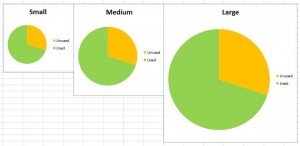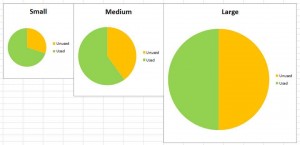Unused Portion
Posted: May 1, 2011 | Author: Steven Harris | Filed under: Collection Philosophy | 3 Comments » Math Math Math. I keep thinking about math. I blame Eric Hellman.
Math Math Math. I keep thinking about math. I blame Eric Hellman.
One of the elements about patron-driven collections that I talk about a lot at my institution is that it doesn’t seem like a good use of funds to buy a lot of books that never circulate. (See Hardesty or Kent.) A thought that keeps coming to mind is that it is probably impossible for anyone to predict exactly what is going to get used by another person (librarians predicting for students or faculty, faculty predicting for other faculty, vendors predicting for everyone). Thus, there will always be a percentage of a “selected” collection that never circulates. Is that percentage static? In other words, will 30% of the collection go unused regardless of whether the collection has 200,000 volumes or 20 million volumes.
In most previous library collection development models, even if the unused portion remains a constant, it makes sense to increase the size of the library as much as possible. A bigger collection will mean more used items (and more unused items too). A few questions about this model come to mind. Is the unused portion really constant? Might a smaller collection actually circulate at a higher rate? And is it really worth the additional expense of growing the collection as much as possible? Is there a point of diminishing returns?
 I think a mix of patron-driven and selected collections might be the most effective. Librarians and approval plans could supply a core of materials. Although, as I’ve suggested, a percentage of those would likely never be used. But it would be a smaller amount of selection than in the past. Users then would otherwise get what they want in an on-demand fashion. This kind of model does suggest that we need to deliver user-requested materials as quickly as possible. Students, for example, may not want to wait 2 weeks, even 2 days for materials to be available. Ebooks, of course, are ideally suited for this kind of process. Many ebook vendors are now offering on-demand collection building models. Can we afford to continue building the just-in-case kinds of collections? Or should we be embracing the patron-driven, just-in-time kind of plan?
I think a mix of patron-driven and selected collections might be the most effective. Librarians and approval plans could supply a core of materials. Although, as I’ve suggested, a percentage of those would likely never be used. But it would be a smaller amount of selection than in the past. Users then would otherwise get what they want in an on-demand fashion. This kind of model does suggest that we need to deliver user-requested materials as quickly as possible. Students, for example, may not want to wait 2 weeks, even 2 days for materials to be available. Ebooks, of course, are ideally suited for this kind of process. Many ebook vendors are now offering on-demand collection building models. Can we afford to continue building the just-in-case kinds of collections? Or should we be embracing the patron-driven, just-in-time kind of plan?
References:
Hardesty, L. 1981. “Use of library materials at a small liberal arts college.” Library Research 3: 261–-82.
Kent, A., et al. 1979. Use of library materials: The Universityof Pittsburgh study. New York: Marcel Dekker.

From the perspective of a library that supports teaching and learning, not research, it is critical that materials be here when they are needed. Delays in access usually diminish our patrons view of our ability to help them. Everyone is okay with occasionally getting materials on loan, but if even half of requests required a period of waiting it would damage our relationship significantly. Indeed, e-book purchase are ideal for patron-driven acquisitions, and there is a place for that in the spectrum of collections access. How much are we going to rely on that format? Their convenience is alluring but I doubt how well they have been integrated into the student (and faculty) teaching/learning landscape. WE still need physical materials here and now. This shifts the burden back to the library to make the most informed selection decisions possible, constantly retooling the formula, and forecasting anticipated needs.
Jennifer, I appreciate the need for immediate local access, but how accurately can you predict that? And what are you’re users doing when you don’t have the information they need?
The issue of predicting need effectively is of course fraught with miscalculation. My thought is simply that becoming more personally engaged with patrons’ needs instead of the reverse would go a long way toward strengthening the relationship we desire with them. I agree with your position that there is most likely a very real and valid point of diminishing returns in a large university library,one that doesn’t probably exist for a smaller library. In a past job in a unit of a major university library the official line was “we buy almost everything in the catalog except titles that fall completely outside our collection, those that are complete duplication or known to be of questionable quality/merit.” This is in contrast my current library that carefully selects a handful of titles from catalog and actively solicits suggestions from the faculty. — As for filling needs that extend beyond our scope, the usual methods of ill and helping them find a question we can answer… don’t forget many patrons come to the library at the last minute with an almost completely unformed research question or plan.